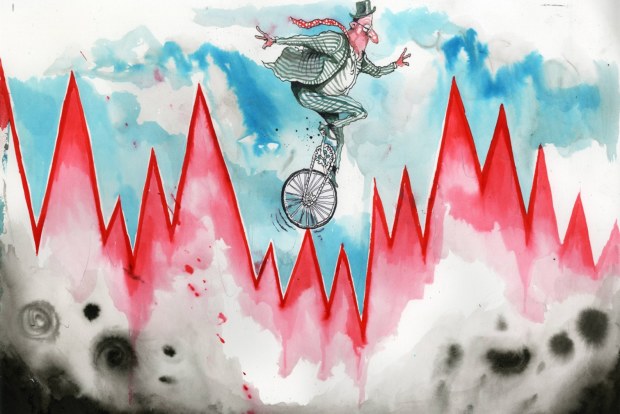Chanticleer

The ASX 200 has gone nowhere for 16 years
It’s not just bond yields testing levels seen since just before the GFC. The ASX 200 is back where it was in November 2007, as Wall Street faces a cucial test.
With bond yields surging back to levels not seen since 2016 in recent months, there has been no shortage of comparisons between the current state of markets and that on the eve of the global financial crisis.
As Chanticleer has pointed out, for all the similarities – a consensus belief in a soft landing despite hawkish central banks, resurgent inflation, resilient equity markets, housing markets stabilising and accelerating – there are key differences. The banking system is much safer, for example, and corporate debt levels are much lower, particularly in Australia.

Surging bond yields may have finally hit the ASX. David Rowe
But as the ASX 200 fell again on Monday amid rising geopolitical tensions – it has now dropped 3.4 per cent since last Wednesday’s close – this column cannot resist noting the benchmark index now sits at essentially the same level it was at the start of November 2007.
This simplistic measure doesn’t include dividends, of course, and ignores the fact that over 10 years and 20 years investors are sitting on gains of 109 per cent and 27 per cent. But amid all these nasty GFC flashbacks, the Australian market’s performance in the past 16 years is a reminder that local investors have basically seen a long leap sideways since the eve of the Great Recession.
Of course, there’s not much to lift sentiment right now, as local traders wake up each morning to a toxic cocktail from Wall Street.
First, bond yields keep rising; the benchmark US 10-year Treasury yield rose again during trade in Asia on Monday to sit around 4.99 per cent, with the Australian 10-year yield ticking up to 4.78 per cent, the highest since 2011.
And second, the risks from the conflict in the Middle East keep escalating, with markets petrified that Iran will be drawn into the fray.
While geopolitical turmoil tends to weigh on bond yields, concerns that a resilient economy will force the US Federal Reserve to keep interest rates higher for longer in a debt-laden US economy means bond traders just keep selling. (Bond prices move in the opposite direction to bond yields).
It’s taken a while, but equity investors have got the message that they’re in a sticky situation. The Australian market has fallen 8.2 per cent since the start of August, while Wall Street’s S&P 500 index is down 7.7 per cent at 4224.2 points.
That puts the S&P 500 within spitting distance of 4200 points, which is widely viewed as the key level of technical support for Wall Street heading into Christmas. If the market breaks below that level, which is close to its 200-day moving average, the fear is it could keep going.
One of the biggest bears on Wall Street, Bank of America strategist Michael Hartnett, is among the many watching the 4200 mark closely. He believes investors are now sufficiently bearish for the market to hold at that level for the next three or four weeks, pointing out the BofA’s Bull & Bear indicator dropped to a level classified as “extremely bearish” last week.
The indicator has reached that level 20 times since 2022. And on average, three months later US stocks have been 5.4 per cent higher, and global stocks have risen 7.6 per cent.
To be clear, Hartnett remains bearish, suggesting investors, “nibble, rent but don’t gorge” on stocks. He says “rallies should be sold” and oil rallying beyond $US100 a barrel (Brent crude was at $US92 on Monday) or the US 10-year yield rising above 5 per cent would likely end any late-year rally.
And with a characteristic burst of pessimism, Hartnett says if the S&P 500 “can’t hold at 4200 with this level of bearishness, then there may be imminent risks of a credit event or hard landing.”
The next few months could be telling. But perhaps ASX investors should think about the bigger picture. Despite all that’s happened in the past 15 years – the GFC and recovery, the pandemic and recovery – they don’t have a lot to show for it.
Introducing your Newsfeed
Follow the topics, people and companies that matter to you.
Find out moreRead More
Latest In Equity markets
Fetching latest articles